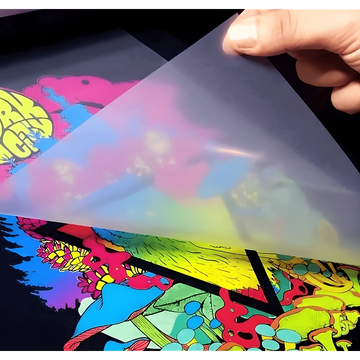TL;DR
Great DTF prints start with great film. The film you choose affects color vibrancy, edge sharpness, peel smoothness, and even production efficiency.
Learn how to spot a quality DTF film—and how the wrong one can quietly kill your profit margin.

1️⃣ What Makes DTF Film So Important?
DTF (Direct-to-Film) printing transfers ink from a coated PET film onto fabric using heat and adhesive powder.
That means your film is literally the foundation of every print.
A good DTF film ensures:
-
Ink stays sharp — no bleeding or spreading.
-
Powder coats evenly — smooth surface, even bonding.
-
Clean peel — no edge tearing or ghosting.
-
Consistent release — predictable transfers every time.
Cheap or unstable film causes:
❌ Fuzzy edges
❌ Ink migration
❌ Static dust spots
❌ Peeling issues after washing
2️⃣ 3 Main Types of DTF Film (and When to Use Them)
| Type | Peel Timing | Best For | Key Benefit |
|---|---|---|---|
| Hot Peel Film | Peel right after pressing | High-speed production | Fastest workflow |
| Warm Peel Film | Peel when film is warm (not hot) | General-purpose jobs | Balance of quality & speed |
| Cold Peel Film | Peel after cooling | Small text, detailed art | Cleanest edges, most forgiving |
Pro Tip:
If your team handles large daily volumes, go with hot peel for faster turnaround.
If you’re doing fine logos or detailed artwork, use cold peel for cleaner results.
3️⃣ Film Surface: Why Double-Matte Anti-Static Is a Game-Changer
Double-matte anti-static films are the industry gold standard.
✅ Smoother feeding in roll printers
✅ Anti-dust, no static buildup
✅ Cleaner powder spread
✅ Easier stacking, no sticking
✅ Better consistency for long runs
If you’re scaling up production or running automated powder shakers, this feature saves hours of downtime.
4️⃣ 75μm vs 100μm: Which Thickness Fits You?
| Thickness | Pros | Best For |
|---|---|---|
| 75μm | More flexible, lower cost | Small shops, mixed fabrics |
| 100μm | Flatter, stable feeding | Large runs, wide printers |
👉 Rule of thumb:
Go 75μm if you print many garment types in small batches.
Go 100μm if you focus on long runs and need perfect registration.
5️⃣ Quick Testing Checklist Before Full Production
-
Print a 10×10 cm test image.
-
Apply powder and cure.
-
Press and peel as normal.
-
Check:
-
Edge clarity
-
White coverage
-
Peel smoothness
-
Wash test (40°C, 5 cycles)
-
If edges lift or colors fade — your film or curing settings may need adjustment.
6️⃣ Top 5 Film Mistakes to Avoid
-
Using glossy films → static issues, dust spots
-
Skipping humidity control → curled films
-
Using wrong peel type → tearing or ghosting
-
Skipping post-press step → poor wash durability
-
Mixing film and powder brands → inconsistent adhesion
🏆 Final Takeaway
DTF film is not just a carrier — it’s a critical performance component.
Choose the right type (hot, warm, or cold peel), the right coating (double-matte), and the right thickness (75µm or 100µm), and you’ll get sharper prints, faster peels, and happier customers.
💪 Why Choose KungFuDTF?
At KungFuDTF, we manufacture and supply:
-
🧩 Hot, warm, and cold peel films
-
⚡ Double-matte anti-static coatings
-
🎯 75μm & 100μm thickness options
-
🧪 Tested with KungFu inks and TPU powder for perfect adhesion
Get consistent quality from a factory-direct source — and boost your print shop’s efficiency today.






